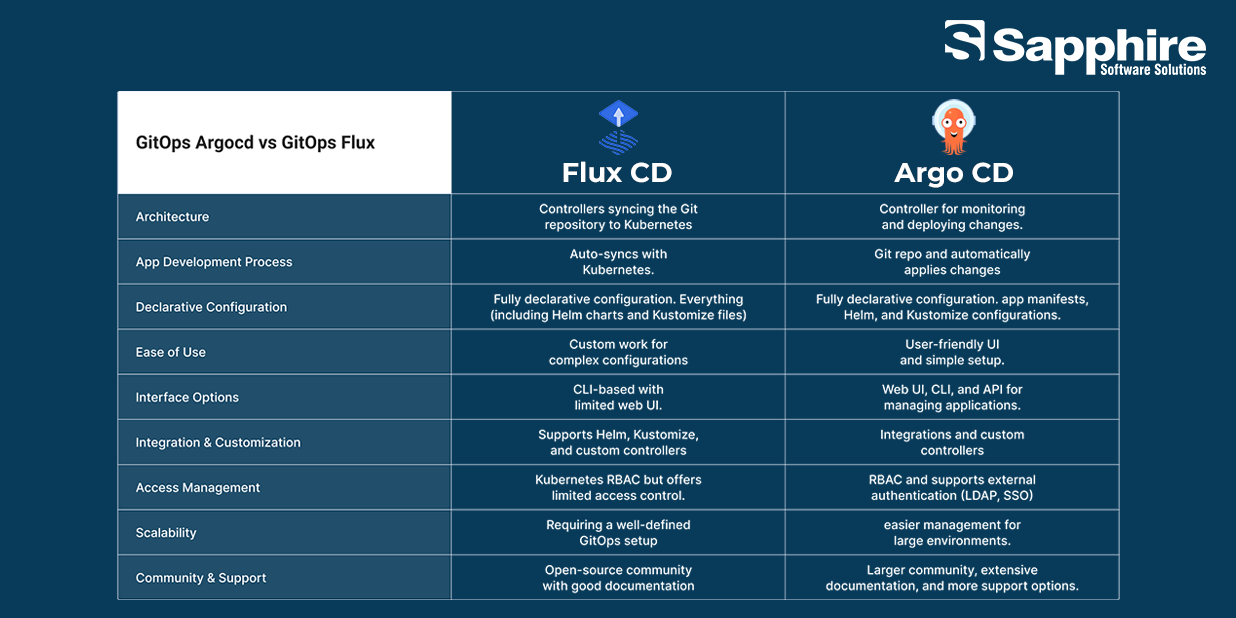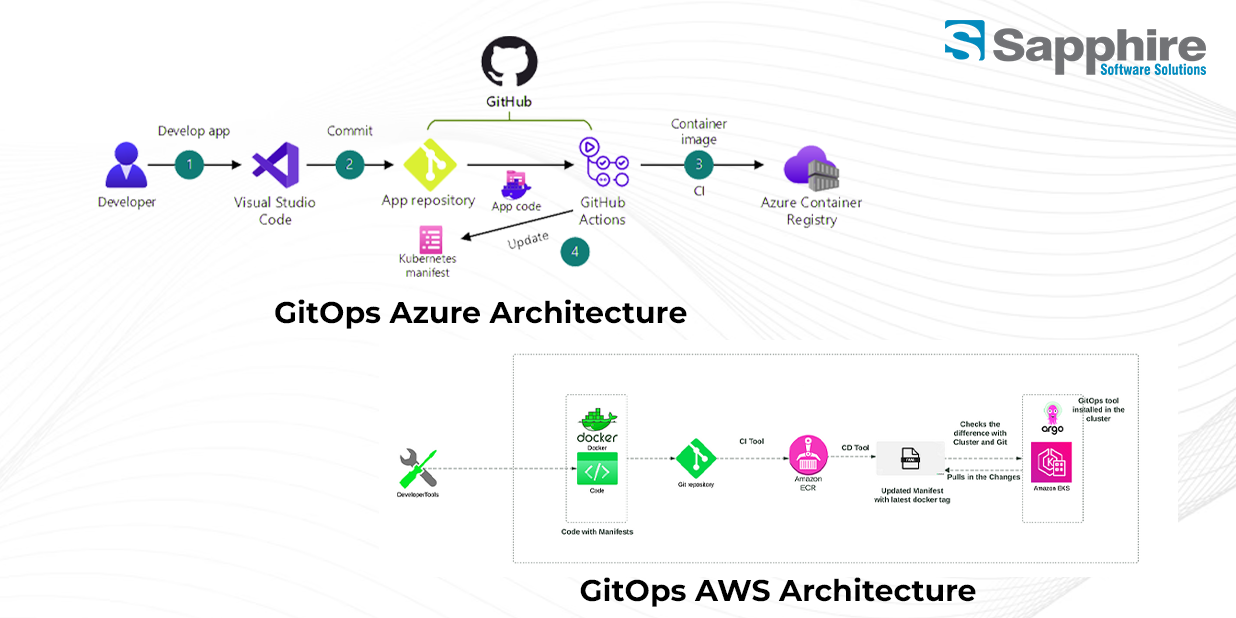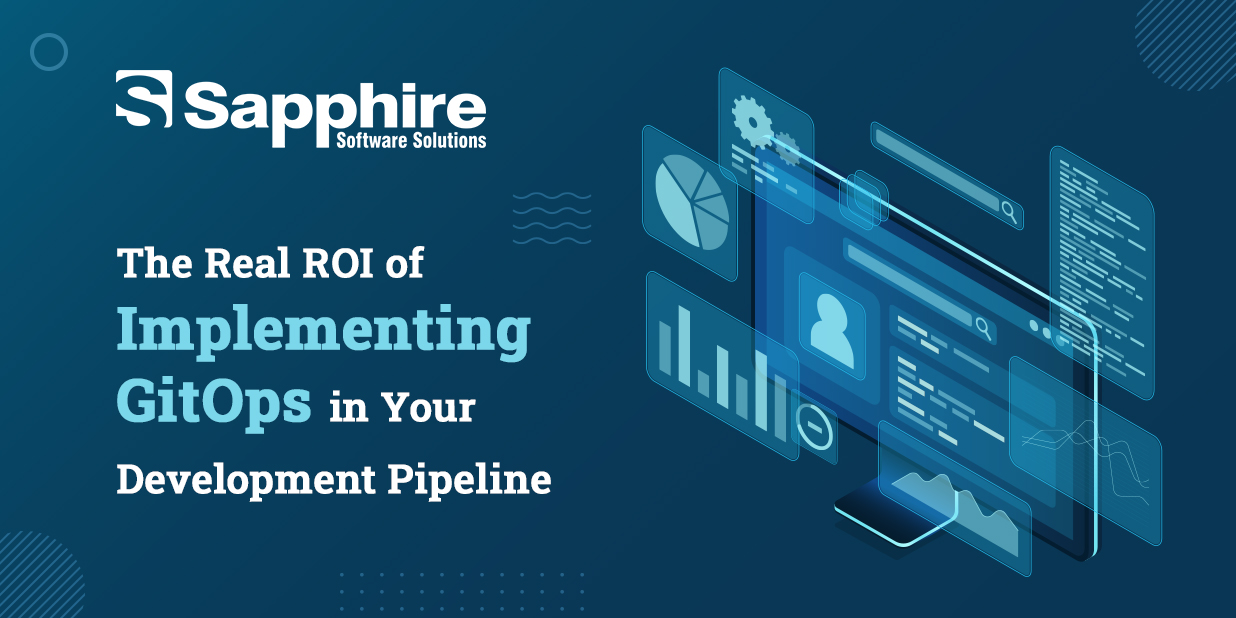As we all are familiar with the growing trend in technology, GitOps has been the most unheard-of phenomenon until it became one of the leading solutions to automate the development and deployment cycle of modern software development. As your application code and your infrastructure both have one source of truth which is Git, GitOps helps teams handle deployments, monitoring, and scaling more automatically, more consistently, and more effectively. The declarative aspect of this model reduces human intervention, eliminates configuration drift, and enhances collaboration between teams, leading to faster and more reliable delivery cycles.
Whether you are a business leader, team leader, or developer looking to gain an understanding of GitOps and how your process can be optimised by it, we’ll delve into the real return on investment (ROI) of applying GitOps in your development pipeline, compare and contrast the strengths and weaknesses of GitOps argocd vs. GitOps flux, and guide you through the gamut of tools, architectures, and services that will enable you to realise the full potential of GitOps.
What is GitOps?
It’s good practice to have an idea of what exactly GitOps is before diving into the technicalities. In simple terms, GitOps is an operational model based on using Git repositories as the single source of truth for declaring and governing infrastructures and application configurations. GitOps is different from other traditional DevOps patterns that tend to depend on manual configurations on a large scale or imperative deployment models because GitOps provides a declarative approach. This implies that the desired state of applications and infrastructure is kept in Git, and on any change of state, there is automatic creation of the desired action of deployment, monitoring, and update.
Consider GitOps as a “Git-based DevOps” method that has several advantages, such as improved reliability, consistency, and automation throughout the development process.
Why GitOps Is Important to Contemporary Development Pipelines?
With today’s fast software development era, companies must ship code quickly, have high availability, and ensure that the operation and development teams are in total harmony. GitOps workflows assist companies in accomplishing these necessities by allowing companies to deploy quickly and reliably while minimising manual manipulation, mistakes, and downtime.
Whether you are building on AWS or Azure, using GitOps in your build pipeline can make you more efficient, enhance collaboration, and keep your infrastructure perpetually in the state you desire.
Let us get into the details of how it is poised to become the game-changer businesses need.
GitOps Argocd vs GitOps Flux: Which GitOps Engine Should You Choose in 2025?

1. GitOpsArgocd:-
Argo CD is a declarative, GitOps continuous delivery system for Kubernetes. It manages the deployment of the application within a Kubernetes cluster and keeps the deployed state in synchronisation with the stored state within Git.
Key Features:
- Real-time Sync: Argo CD allows real-time synchronisation of your Kubernetes clusters with your Git repository, so any modifications to Git are programmatically generated.
- Application Management: It comes with a user-friendly dashboard for handling multiple applications and environments, suited for big deployments.
- Rollback Capabilities: Argo CD supports rolling back to a former version of the application at a click.
2. GitOpsFlux:-
Flux is another well-known GitOps engine that is aimed at automating the deployment and management of Kubernetes workloads. Like Argo CD, it is centred on continuous delivery, but through a different method and is more diverse in its design philosophy compared to Argo CD.
Key Features:
- GitOps Native: Flux adheres more to the GitOps way of thinking by emphasising syncing your Kubernetes with your Git repository through a declarative configuration model.
- Integration with Helm: It integrates natively seamlessly with Helm, which is a utility tool across the industry for Kubernetes application management.
- Lightweight and Flexible: Flux has been made lightweight, so it will perform well in cases where minimum overhead is a necessity.
Which One Should You Use?
In 2025, Argo CD and Flux have both come a long way, so your decision will depend mostly on your team’s requirements:
- If you want an easy-to-use, highly featured dashboard to operate applications at scale, Argo CD may be the ticket.
- If your ops team needs a lighter, more flexible solution with excellent Helm integration, Flux may be the ticket.
Building a Scalable GitOps Architecture with Argo CD and Kubernetes:-
When shifting to GitOps, a key issue is building a scalable and scalable architecture. Regardless of whether you are using GitOps, argocd or Flux, a Kubernetes-based architecture offers the perfect foundation to host and execute applications in a declarative and automatic manner.
Principles of Scalable GitOps Architecture:
- Kubernetes as a Foundation: Kubernetes is the natural choice for GitOps since it supports declarative configuration and scaling natively. It also gets along quite well with tools like Argo CD and Flux.
- Infrastructure as Code (IaC): By keeping all your infrastructure configs (network settings, deploy scripts, secrets, etc.) in Git, you’re making the whole system more transparent and version-controlled.
- Automated Deployment Pipelines: Continuous integration and continuous delivery (CI/CD) pipelines are crucial to make sure code and infrastructure updates cause the correct thing.
- Self-healing and Observability: A good observability configuration (monitoring, logging, and alerting) allows issues to be caught early, and the self-healing aspect of GitOps is such that the desired state is always reconciled.
From CI/CD to GitOps: Familiarising Yourself with the GitOps Model and Methodology:-
In traditional DevOps, Continuous Integration and Continuous Delivery (CI/CD) pipelines carry out building, testing, and application deployment. This extends CI/CD’s ideas further to more strongly root Git at the centre of your operations.
GitOps Model:
- Git as the Single Source of Truth: With the GitOps approach, all configuration and deployment scripts are committed to Git repositories. This offers a single, versioned source of truth for your application infrastructure in general.
- Declarative Infrastructure: Contrary to having to declare servers or services manually, infrastructure is declared within Git. During a change in state in Git, the system automatically makes the infrastructure consistent with new state.
- Continuous Reconciliation: GitOps systems such as Argo CD or Flux continuously scan your Git repositories and reconcile the infrastructure state against the desired state so your system always stays up to date.
GitOps Approach:
- Rollbacks Automated: With GitOps, any error or misconfiguration can be reversed at once by reverting to a previous point in Git, reducing errors and downtime.
- Team Collaboration Workflow: The developers can contribute directly to the infrastructure since they control the configurations in Git, resulting in better team collaboration.
- Security and Compliance: Organisations can keep their security in a more effective manner because GitOps offers version control for the infrastructure changes, therefore simpler auditing and tracking of configuration changes.
How to Choose Between GitOps AWS and GitOps Azure for Your Architecture?
One of the fundamental decisions when implementing GitOps is whether to use AWS or Azure, two leading cloud providers, to integrate your workflow with.

GitOps AWS:-
AWS provides you with a line of services, which are the most suitable for GitOps workloads, such as Amazon EKS (Elastic Kubernetes Service) and AWS CodePipeline for CI/CD. GitOps AWS enables you to connect Kubernetes clusters with AWS resources in an instant, so that scaling and efficiency become an instant process.
GitOps Azure:-
Azure also has a similarly mature set of tools to manage Kubernetes via Azure Kubernetes Service (AKS) and Azure DevOps pipelines. GitOps Azure enables you to maintain your infrastructure in a declarative state while taking advantage of Azure security and scale.
Which One to Choose?
Benefits of Hiring a GitOps Development Company for Enterprise DevOps:-
For those companies wanting to implement GitOps but do not have in-house expertise, then it is worthwhile to partner with an expert. These companies work on creating, implementing, and running GitOps-based workflows and you will see the full return on GitOps without having internal teams to train.
- Expertise: A GitOps development company is well-versed in what constitutes the best tooling, architecture, and processes.
- Quicker Deployment: With their expertise, the time it takes to deploy and set up your GitOps deployment is shorter.
- Detailed Support: These companies provide continued support, which supports your GitOps flows expand with your business needs.
Why You Should Implement Sapphire for GitOps Development Services?
If you’re looking for a GitOps development company to help implement and optimize your GitOps workflows, consider choosing Sapphire Software Solutions. We offers expert GitOps development services that can streamline your DevOps pipelines, ensuring that your teams can deploy and manage applications with maximum efficiency.
Sapphire’s engineers are very well-versed with GitOps argocd, GitOps flux, and both GitOps AWS and GitOps Azure, which makes them the ideal solution to resolve the most intricate infrastructure problems. Dedicated deeply to bringing value through automation, security, and scalability, Sapphire is the ideal solution to assist you in unlocking the actual ROI of GitOps.
From automated rollbacks to simplified management, GitOps brings stability & agility to your development
Conclusion:-
Using GitOps in your development workflow results in a massive return on investment as far as more automation, elimination of human errors, and more collaboration between ops and development teams are concerned. Be it GitOps argocd or GitOps flux that you opt for and be it AWS or Azure that you deploy on, using GitOps to deploy can automate and overhaul your deployment and infrastructure management process.
By collaborating with a GitOps development firm like Sapphire, you can speed your adoption of GitOps and derive the full benefit of this paradigm-shifting methodology. The software development future is declarative, automated, and Git-based—don’t wait to be in on the revolution.






































